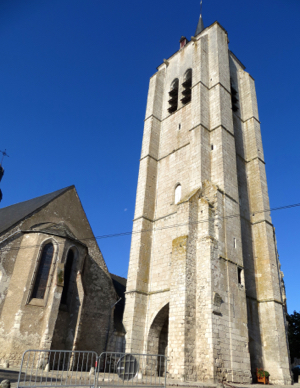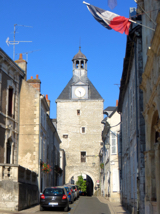 |
Beaugency, Loire Valley, France | |
| A small town made famous in a historic children's song. | ||
|
|
||
|
|
|
As we explored the history of the charming children's song, "Orléans, Beaugency, Notre-Dame de Cléry, Vendôme, Vendôme," we were delighted to come upon the small village of Beaugency, on the right bank of the Loire, about 33 kilometers (21 miles) southwest of Orléans (map). With a population of about 7,600, Beaugency is large enough to support a lively and colorful market. It was an important center in the 11th through the 13th century, in part because of its location on the Loire. Many vestiges of the Middle Ages remain, and a quick walking tour through the town will take you by these landmarks. We were most interested in the Clocher St-Firmin. This bell tower is all that remains of an 11th century church that was destroyed during the Revolution. Twice a day, its bells chime the tune of Orléans, Beaugency, Notre-Dame de Cléry, Vendôme, Vendôme. And of course the requisite statue of Joan of Arc is here, just across from the clocher. The Abbey Church of Notre-Dame is a short walk from the tower. This church, which was originally built in the 11th century, was rebuilt in the 17th century. It is perhaps best known as the place where the council of Beaugency met to annul the marriage of King Louis VII of France and Eleanor of Aquitaine. Eleanor later married the future King of England, Henry Plantagenet. Her dowry included a large section of southwest France (Aquitaine), which did not please the French. Near the abbey church is the colorfully-named Devil's Tower, part of the original town fortifications. When it was built, it was on the Loire, but is now somewhat inland, near the bridge across the river. Fun note: A local legend, made popular by James Joyce, says that the bridge was built by the devil in one night. In exchange, the devil would possess the soul of the first person who crossed the bridge. The townspeople tossed a bucket of water on a black cat, and the cat was thus the first to cross the bridge! The devil was angry and accused the people of not being nice, and being nothing but cats. The cat has been a symbol of Beaugency since then. The Château Dunois, also called Château de Beaugency, is a large seigneurial house, now a museum. It offers many programs, particularly for children. The Clock Tower, or Tour de l'Horloge, has been a gateway to Beaugency since the 12th century. It is near the Hôtel de Ville, or town hall. The Hôtel de Ville has some lovely 17th century embroideries and provides guided tours. The Tourist Information Office is located at 3, Place du Dr Hyvernaud, near the market. As you visit these landmarks, you'll also see lovely medieval domestic and commercial architecture in the homes and shops of the town. And for nature lovers, just across the Loire is Les Rives de Beaugency, a nature preserve that is home to more than 400 different plants. From Beaugency you can cross the Loire and make the short drive (12 kilometers, about 7 miles) to Cléry-Saint-André, the next spot featured in the song (map)! Beaugency is a bit "à coté." That is, you won't find it on a lot of tourist itineraries. But if you want to see a small French village in a lovely location, Beaugency qualifies.
|
|

Above, Clocher St-Firmin, where the angelus chimes the tune twice a day.
|

